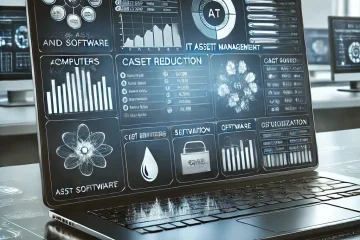Introduction
In today’s digital landscape, businesses depend heavily on their IT infrastructure. Managing IT assets—ranging from hardware to software licenses—can be complex and time-consuming without the right tools. IT asset management software is designed to track, manage, and optimize the use of these resources, helping businesses operate smoothly and efficiently.
In this guide, we’ll explore what IT asset management software is, its key features, and how it can benefit modern businesses by streamlining operations and reducing costs.
1. What is IT Asset Management Software?
IT asset management (ITAM) software helps businesses track and manage their IT assets throughout their lifecycle, from procurement to disposal. IT assets include computers, servers, software licenses, and other digital infrastructure. ITAM software provides real-time visibility into asset location, usage, and maintenance needs, enabling better decision-making and resource optimization.
The software aims to improve efficiency, reduce costs, and ensure compliance with industry regulations.
2. Key Features of IT Asset Management Software
When selecting IT asset management software, it’s essential to look for features that meet your business needs. Below are key features to consider:
a. Real-Time Asset Tracking
One of the core features of ITAM software is real-time asset tracking. It allows businesses to monitor hardware and software assets continuously, ensuring accurate inventory records. This feature reduces the chances of lost or misused assets and helps businesses make informed decisions about asset deployment.
For example, if an IT team deploys new hardware, the software updates inventory levels in real time, maintaining an organized system.
b. Lifecycle Management
ITAM software manages assets throughout their entire lifecycle. It tracks each stage, from procurement to deployment and eventual retirement. Businesses can schedule maintenance and track warranties, preventing unexpected breakdowns and reducing downtime.
Lifecycle management allows companies to plan asset replacements in advance, minimizing the risk of disruptions due to equipment failure.
c. License and Compliance Management
Managing software licenses and ensuring compliance is a critical aspect of IT asset management. ITAM software tracks software licenses, usage, and expiration dates, ensuring that businesses remain compliant with licensing agreements. This feature helps avoid costly penalties for non-compliance and ensures that companies only pay for the licenses they actually use.
Tracking software usage also allows businesses to reassign unused licenses, optimizing software expenses.
d. Automated Alerts and Notifications
To prevent downtime or non-compliance, ITAM software offers automated alerts. These notifications remind businesses when licenses are due for renewal or when assets require maintenance. Proactive alerts help companies avoid interruptions in service, ensuring business continuity.
This feature keeps businesses informed of asset performance and helps maintain operational efficiency.
e. Integration with Other IT Tools
Integration capabilities are vital for businesses using multiple IT tools. IT asset management software should integrate with IT service management (ITSM) platforms, accounting software, and enterprise resource planning (ERP) systems. This integration ensures that asset-related data flows seamlessly across different systems, creating a holistic view of the company’s IT infrastructure.
For example, integrating with ITSM systems allows IT teams to link assets directly to service tickets, improving response times and asset issue resolution.
3. Benefits of IT Asset Management Software
Implementing IT asset management software can transform how businesses manage their IT resources, leading to numerous benefits:
a. Increased Asset Utilization
ITAM software provides real-time visibility into asset usage, allowing businesses to maximize asset utilization. Companies can identify underused assets and reallocate them where needed, optimizing resource usage and avoiding unnecessary purchases.
For instance, if certain software licenses are underutilized, businesses can reassign them to departments with higher demand, reducing software expenses.
b. Cost Savings
One of the primary benefits of ITAM software is cost savings. By managing IT assets more effectively, businesses can minimize unnecessary purchases, reduce maintenance costs, and optimize software licensing. The software also helps extend the lifespan of assets through proactive maintenance planning, reducing the need for frequent replacements.
By keeping track of all assets, businesses avoid the costs of lost or misused equipment and streamline their purchasing decisions.
c. Improved Security and Compliance
ITAM software enhances security by tracking all IT assets connected to the network. This visibility helps identify unauthorized devices or software, ensuring that businesses maintain secure and compliant environments. Additionally, the software ensures that companies comply with licensing agreements and industry regulations, preventing fines and legal issues.
By maintaining accurate asset records, businesses can quickly meet audit requirements and avoid penalties.
d. Reduced Downtime
With proactive maintenance alerts, businesses can reduce the risk of unexpected asset failures. ITAM software helps schedule maintenance and track warranty expiration dates, allowing companies to address issues before they cause downtime. This proactive approach minimizes disruptions and keeps critical systems running smoothly.
By scheduling regular maintenance, businesses can ensure that IT systems remain operational without sudden interruptions.
e. Data-Driven Decision Making
The reporting and analytics features of ITAM software provide businesses with valuable insights into asset performance, utilization, and costs. These data-driven insights help IT teams make informed decisions about asset procurement, upgrades, and replacements.
For example, if certain equipment frequently experiences issues, the software can provide data to support decisions on whether to repair or replace it.
4. Choosing the Right IT Asset Management Software
When selecting IT asset management software, businesses should consider several factors:
- Scalability: Choose a system that can grow with your business.
- User-Friendly Interface: Opt for software with an intuitive interface to ensure easy adoption.
- Vendor Support: Ensure the vendor offers robust customer support to address any issues.
It’s important to select software that integrates well with your current systems and can accommodate future growth.
Conclusion
In the modern business environment, effective IT asset management is crucial for maintaining operational efficiency, reducing costs, and ensuring compliance. IT asset management software offers businesses the tools they need to track, manage, and optimize their IT assets, providing real-time insights and automating processes that would otherwise be time-consuming and prone to error.
By partnering with a trusted software company in Delhi, businesses can implement ITAM solutions that streamline their IT operations, enhance security, and ensure business continuity.



0 Comments